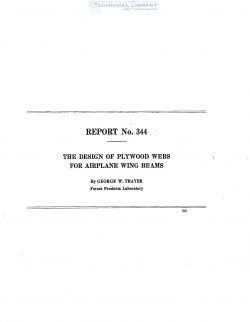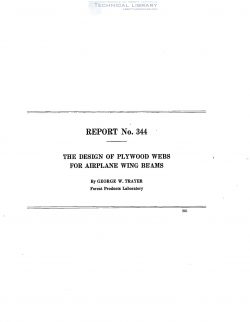naca-report-344

- Version
- 248 Downloads
- 1.31 MB File Size
- 1 File Count
- August 25, 2016 Create Date
- August 25, 2016 Last Updated
National Advisory Committee for Aeronautics, Report - The Design of Plywood Webs for Airplane Wing Beams

This report of the Forest Products Laboratory deals with
the design of plmeood webs for wooden boa: beams to obtain
maximum strength perunitireight. Amethod Qfarrivingat
the most efifcient and economical web thickness, and hence
the most suitable unit shear stress, is presented and work-
ing stresses in shear for carious types of webs and species
of plywood are given. The questions of diaphragm spac-
ing and required glue area between the webs and the flange
are also discussed.
The study of wooden box wing beams built with
spruce flanges and plywood webs involves, first, the
design of the flanges and, second, the design of the
webs. The design of the flanges is discussed in previ-
ous aircraft reports prepared by the Forest Products
Laboratory, United States Department of Agriculture,
for publication by the National Advisory Committee
for Aeronautics (Reports Nos. 181 and 188). The
present report deals with the results of tests relating
to the design of the webs. Approximately 200 repre-
sentative box and double I beams were tested at the
Forest Products Laboratory for the purpose of de-
veloping the most efficient and economical design of
plywood webs and to determine the working stresses
for various types of webs. The project was conducted
in cooperation with the Bureau of Aeronautics, Navy
Department.
The function of the plywood webs of box beams for
airplane wings is to resist a very minor portion of the
bending moment and the major portion of the shear
acting on the beam. Tests made at the Forest Prod-
ucts Laboratory indicate that, with plywood in which
the grain of successive plies is alternately parallel and
perpendicular to the longitudinal am‘s of the beam,
only that portion of the plywood in which the grain is
parallel to the axis should be considered in calculating
the moment of inertia I. With plywood in which the
grain of alternate plies forms angles of i45° with the
longitudinal axis of the beam one-half the thickness of
the plywood may be considered in calculating I.
| File | Action |
|---|---|
| naca-report-344 The Design of Plywood Webs for Airplane Wing Beams.pdf | Download |
Comment On This Post